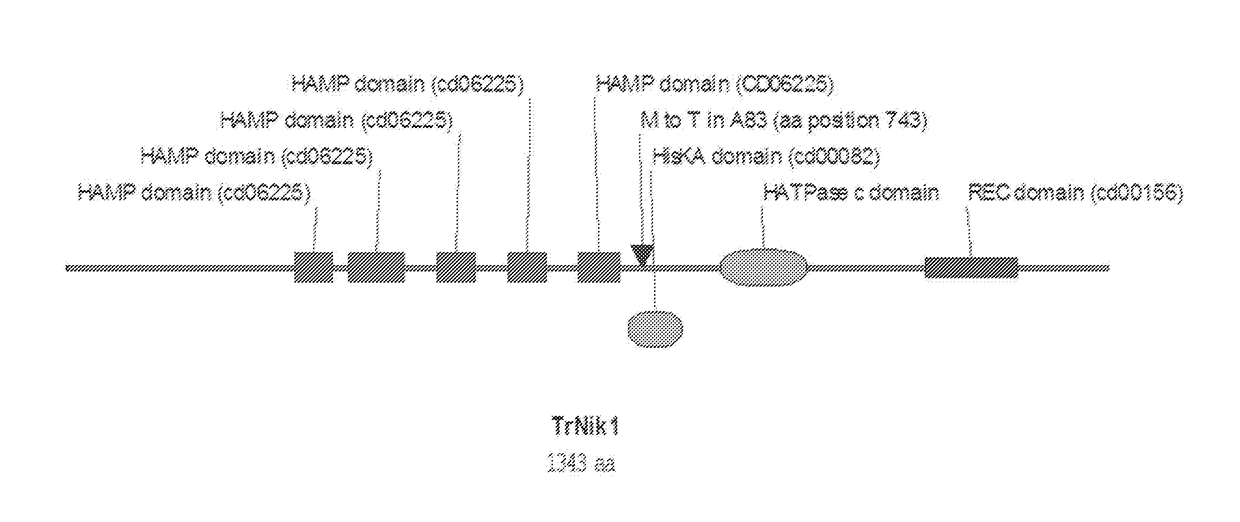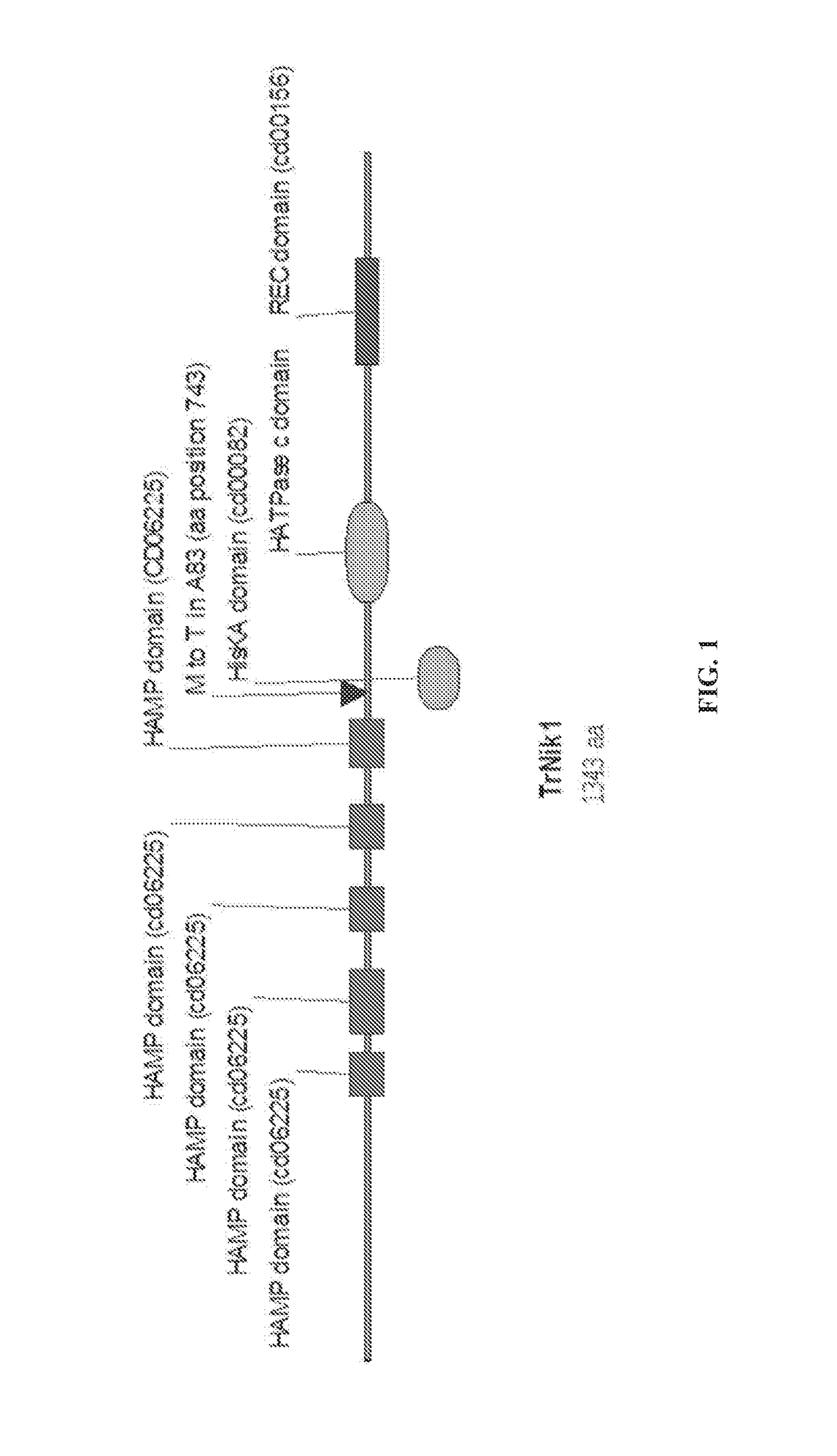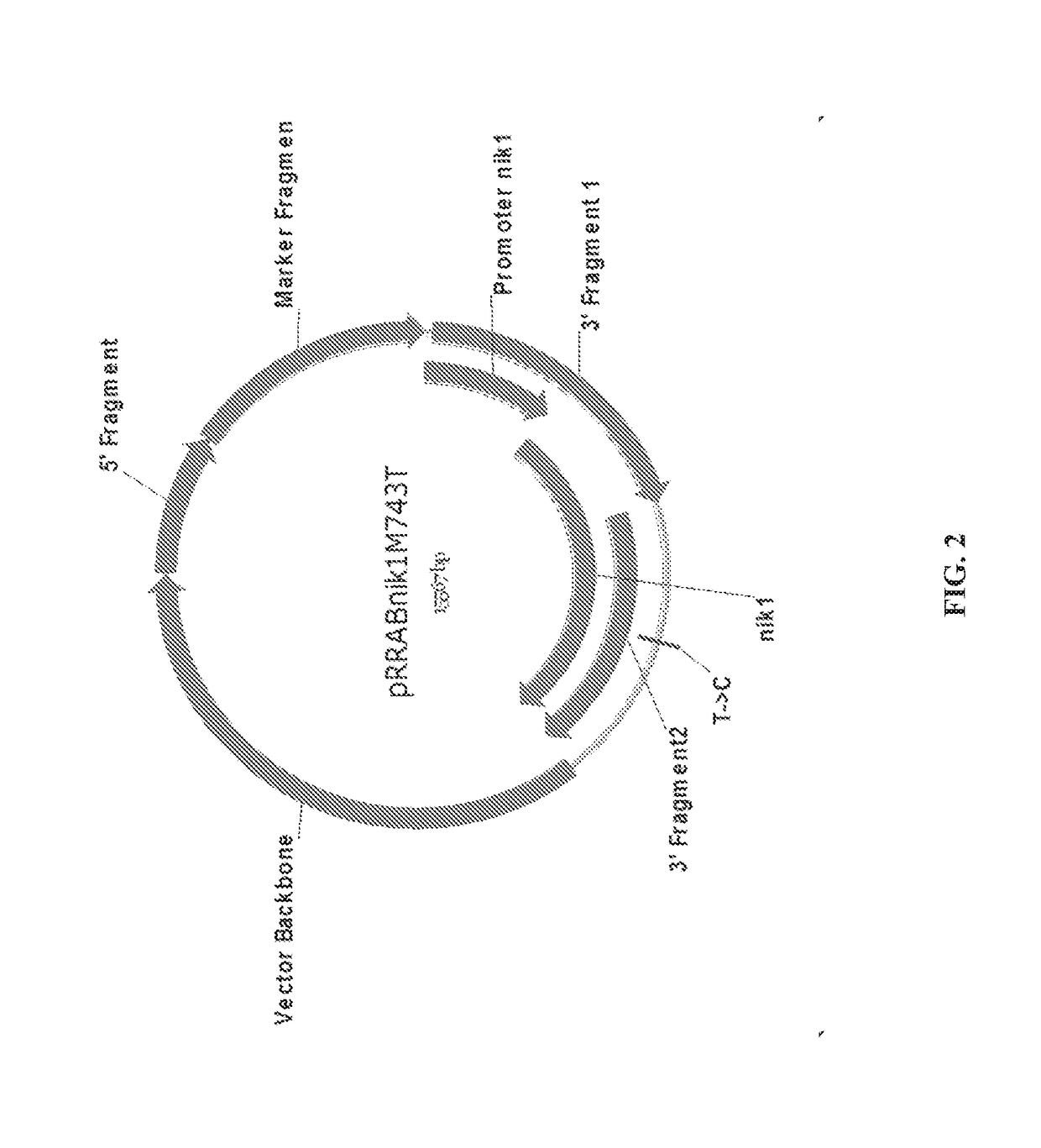Fungal strains and methods of use
a technology applied in the field of fungi and strains, can solve the problems of uneconomical and unsustainable direct use, and the amount of total proteins/enzymes, and achieve the effect of improving protein production
- Summary
- Abstract
- Description
- Claims
- Application Information
AI Technical Summary
Benefits of technology
Problems solved by technology
Method used
Image
Examples
example 1
Creating an Engineered Fungal Strain with One Mutation in Nik1 Gene
1.1 Generation of Nik1M743T Gene Replacement Cassette
[0147]A gene replacement construct was made (FIG. 2) by fusing a DNA fragment containing the 5′ region upstream of the nik1 locus, a loxP-flanked hygromycin B-resistance marker cassette and two DNA fragments containing the promoter and nik1 gene (including the T to C substitution that changes the amino acid at position 743 from methionine to threonine), with the 2μ backbone-containing yeast vector pRS426 (from pRS426 phagemid in E. coli, ATCC® 77107™).
[0148]The following primers were prepared by Integrated DNA Technologies, Inc. (Coralville, Iowa, USA)
[0149]RRab88 (Forward)—5′-CGATTAAGTTGGGTAACGCCAGGGCCTAGGTGGCTTTGAGCGGTGTTGATGTGTA-3′ (SEQ ID NO:2), which was used to amplify DNA sequence upstream of nik1 (5′ Flank) with AvrII restriction site and vector backbone tail overhang for plasmid pRRabnik1M743T.
[0150]RRab89 (Reverse)—5′-TACACATCAACACCGCTCAAAGCCACCTAGGCCCTGG...
example 2
Creating a Fungal Strain with Nik1 Gene Deletion
[0168]2.1 ΔNik1::Hph Deletion Cassette Design and Creation
[0169]A gene replacement construct was made (FIG. 6) by fusing a DNA fragment containing the 5′ flank of the nik1 gene, a loxP-flanked hygromycin B-resistance cassette and a DNA fragment containing the 3′ flank of the nik1 gene with the 2μ backbone-containing yeast vector pRS426 (from pRS426 phagemid in E. coli, ATCC® 77107™). The following primers were made by Integrated DNA Technologies Inc. (Coralville, Iowa, USA).
[0170]RRab266 (Forward)—5′-CCTGGGGAACCCCCCAGCGCCCGGCGAGCTCATAACTTCGTATAGCATACATTAT ACGAAGTTATCCTGGGCTTGTGACTGGTCGCGAGC-3′ (SEQ ID NO:16), which was used to amplify the hygromycin resistance marker with a loxP site along with a SacI restriction site and 5′ Flank tail overhang for plasmid pRRabΔnik1.
[0171]RRab267 (Reverse)—5′-CTTTCGCCGTCCAGGCGTCCAGACACCTGGTATAACTTCGTATAATGTATGCTAT ACGAAGTTATCGGCCGGCGTATTGGGTGTTACGGA-3′ (SEQ ID NO:17), which was used to amplify the hyg...
example 3
Engineered Fungal Strain as an Expression Host of a Cellulase of Interest
[0184]3.1 Transformation of T. reesei Host Strain Overexpressing CBH1 with Nik1M743T Allele-Containing Gene Replacement Cassette, Candidate Selection, Verification and Characterization
[0185]The purified concentrated gene replacement cassette described in example 1.1 was transformed into a T. reesei host strain overexpressing CBH1 using PEG-mediated transformation (Penttila et al., Gene, 61(2):155-64 (1987)). Transformants were plated on Vogel's minimal medium containing 30 μg / mL hygromycin B using overlays, and incubated at 28° C. Genomic DNA from stable transformants resistant to 100 μg / mL hygromycin B was extracted using the NucleoSpin® PlantII kit (Machery-Nagel, Bethlehem, Pa., USA). This genomic DNA was then used as template for diagnostic PCRs to confirm homologous recombination of the gene replacement at the native nik1 locus. The primer pairs RRab117 (SEQ ID NO:14) and RRab167 (SEQ ID NO:15) were used f...
PUM
| Property | Measurement | Unit |
|---|---|---|
| resistance | aaaaa | aaaaa |
| osmotic pressure | aaaaa | aaaaa |
| size | aaaaa | aaaaa |
Abstract
Description
Claims
Application Information
 Login to View More
Login to View More - R&D
- Intellectual Property
- Life Sciences
- Materials
- Tech Scout
- Unparalleled Data Quality
- Higher Quality Content
- 60% Fewer Hallucinations
Browse by: Latest US Patents, China's latest patents, Technical Efficacy Thesaurus, Application Domain, Technology Topic, Popular Technical Reports.
© 2025 PatSnap. All rights reserved.Legal|Privacy policy|Modern Slavery Act Transparency Statement|Sitemap|About US| Contact US: help@patsnap.com



